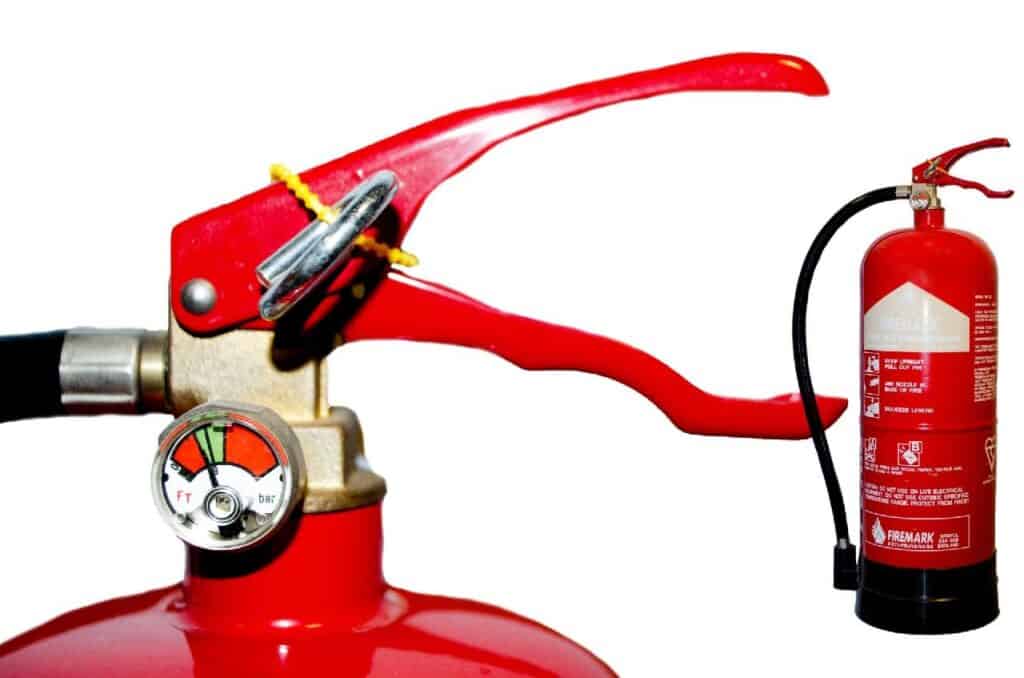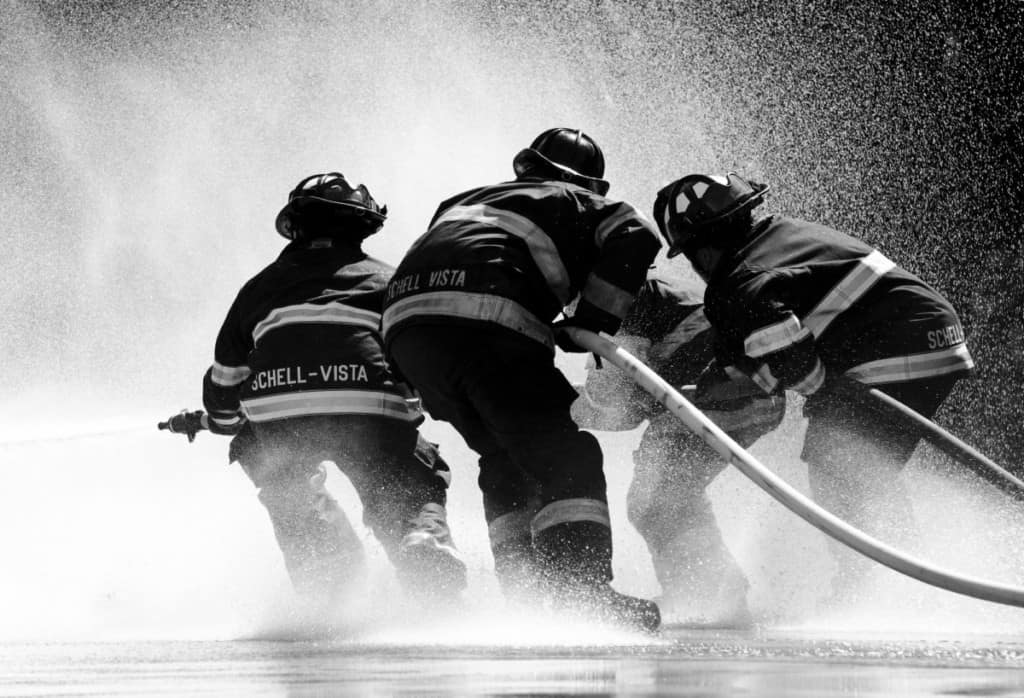If you’ve got a boat then you’re going to want to make sure that everyone stays safe if a fire breaks out onboard (and that your boot isn’t damaged). So, what do you need to do in terms of fire extinguishers and where exactly should you put them on your boat for the best access? Don’t worry, we’ve got you covered with everything that you need to know with rules and best practices.
The best place to store a fire extinguisher on a boat will depend on the size of the boat, the type of extinguisher, etc. In general, the extinguishers should be easily accessible, stored upright, and mounted where they are most likely to be needed.
This article will talk more about the laws regarding fire extinguishers on boats, the different types of fire extinguishers and which is best on your boat, as well as the basics of how to use it if needed. Here is what you need to know.
Your # 1 priority is keeping your family safe. As a firefighter, I recommend everyone has updated smoke detectors that don’t require battery changes, like these ones from Kidde, a fire extinguisher, like this one from Amerex, and a fire escape ladder if you have bedrooms above the first floor, I recommend this one from Hausse.
Also read: Storing a Fire Extinguisher: 5 Things to Keep in Mind
Where Is The Best Place To Store A Fire Extinguisher On A Boat?

The most important consideration in where to store the fire extinguishers, by far, should be the ease of accessibility for these extinguishers.
If you can’t get your hands on them when you need them – you may as well not have bought them in the first place.
Secondly, you want to locate them in places where:
- Fires are more likely to break out, such as the kitchen or engine room
- The potential cost of not putting out a fire could be very serious including high traffic areas (where lots of people might gather).
Finally, to make it easy to find them when you need them.
Mount the extinguishers on the wall near the exits to these areas and ensure that they are stored in a fully upright position (if you don’t the extinguisher may lose internal pressure and perform poorly or not at all when you need it).
Note: in the case of powder extinguishers you may find the powder clumps together when stored horizontally and all you can discharge is the propellant, not the powder).
You should also make a plan to check the condition of your extinguishers on at least a monthly basis.
Keep an eye on the seals and hoses to ensure they are in good shape and weigh them to make certain they haven’t been leaking anything. Also, check the pressure gauges and get them serviced and refilled when necessary.
Questions To Ask About Where To Store Fire Extinguishers On A Boat
If you want a quick “cheat sheet” for locating extinguishers on a boat then ask these simple questions to get your thoughts moving:
- Where is the gas tank on the boat and how can I best protect it?
- Where are the locations where my friends or colleagues, etc. are most likely to group together on the boat?
- Where does the trash end up?
- Where is the kitchen and how well maintained will it be?
- Where am I storing oil, gasoline, etc.?
What Kind Of Fire Extinguisher Do You Need For A Boat?

There are 5 separate classes of fire extinguisher and you won’t need all of them on your boat. However, you will probably need more than one class, and this is what you need to know about each.
- Class A – This is a fire extinguisher that is meant to handle ordinary fires that are made out of “ordinary” combustible materials – think paper fires or fabric fires. They result in “ash” being made (hence Class “A”sh) and you can extinguish them by pouring water on the top of them with a little detergent and that’s what’s in the extinguisher. These are by far the most useful extinguishers on boats. Here is a great ABC (works on class A, B, and C fires) fire extinguisher made by Amerex on Amazon.
- Class B – This is an extinguisher filled with dry powder which is meant to tackle flammable liquids (such as gasoline, oil, etc.) fires involving these materials can rapidly spread as the liquid runs around the boat. You don’t want to try extinguishing these fires with water – the powder not only removes oxygen from a liquid fire but it also soaks up the liquid itself. You may need one or two of these extinguishers on your boat. A
- Class C – If you have to tackle an electrical fire, you want a Class C extinguisher on hand. They are full of CO2 and dry chemicals and the extinguisher is generally used to isolate and then remove the source of electricity in a fire. Never use water on an electric fire unless the electricity source has been removed.
- Class D – You won’t use this on most boats. Class D extinguishers are meant to put out flammable metals (like Sodium or Magnesium) using a dry chemical mix. You shouldn’t have these materials on a boat.
- Class K – This is actually a subset of Class B extinguishers and is used for dealing specifically with cooking oil/grease fires. You use them in the kitchen (galley) on the boat. Here is a perfect Class K extinguisher to use for any cooking oil fires in the kitchen.
For more information about cooking fires, read: Will a Fire Extinguisher Ruin an Oven?
What Does The Law Require For My Boat?
The US Coastguard standard requires anyone with a boat under 26 feet long to have a minimum of one Class B extinguisher on board and if it’s bigger than that, but less than 40 feet long – you need two at a minimum.
This isn’t really enough and we’d strongly recommend that you spend some time assessing the risk areas on your boat and investing in additional extinguishers as needed.
However, you should be aware that there are certain elements that can appear on a boat that require the installation of a US Coast Guard fire extinguishing system and these include:
- Any fuel tanks which cannot be moved or lifted by one person because of their weight or design
- Any seat compartments that have engine tanks stored within them
- Any engine compartments that have been fully enclosed
- Any areas that have been enclosed for the purposes of either living or cooking in
- Any double bottoms which have not been properly sealed to the boat on a permanent basis
- Any regions aboard the boat which cannot be filled with the appropriate flotation devices and/or materials
If this doesn’t apply and you don’t want to go mad on investing in a bunch of different fire extinguishers, then there is an easy solution.
Buy some A, B & C fire extinguishers (these contain a compound known as monoammonium phosphate that essentially acts as the appropriate extinguishing agent in all three separate extinguishers would).
A minimum of three fire extinguishers on your boat and you should be properly prepared for a fire offshore.
For more details on the laws that affect fire extinguisher requirements on boats, read this.
This video covers some myths regarding fire extinguishers on boats that may be helpful:
What To Do If You Need To Use The Fire Extinguisher On A Boat?
Finally, we hope that you never have to use a fire extinguisher on your boat. The best outcome even when investing in firefighting equipment is not to have to deal with a fire at all.
But if you do, then there is a very simple method to tackle a fire with an extinguisher. Use the Acronym PASS to remember the steps.
- P – (Pin) You start by pulling out the pin from the fire extinguisher
- A – (Aim) Then you take aim at the fire with the nozzle or hose – you do this from as far back and as safe a position as possible, you don’t need to stand on top of the fire
- S – (Squeeze) Then squeeze the handle on the fire extinguisher to start the flow of the extinguishing agent
- S – (Sweep) Then sweep the hose/nozzle back and forth from side to side over the top of the flame
Finally, we should note that even at sea – if you feel a fire is growing beyond your control, it is better to radio for help and even abandon ship than to place yourself in serious danger.
Watch this video for a visual of the PASS method:
Conclusion
Where is the best place to store a fire extinguisher on a boat? There is no one best place, instead, you need to look at the size of your boat and what goes on on your boat and then make sensible decisions about what is needed and where to locate them.
Of course, you will also need to consider the legal requirements where you are and make sure that you are acting in full compliance with the law. The thought of a fire on the water may seem a little silly but it’s a very serious problem and failure to take the appropriate precautions can kill.
Related Articles
6 Best Fire Extinguishers For Workshop/Garage/Welding Use

